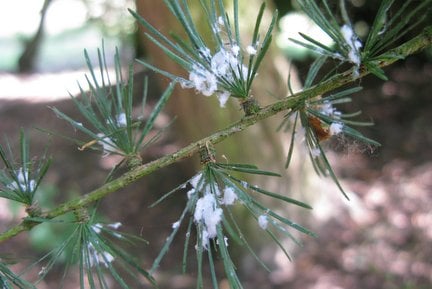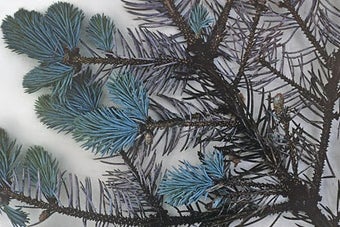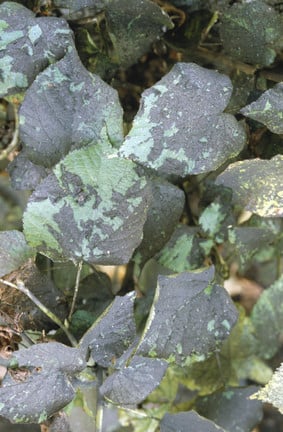
Quick facts
Common name - Adelgids
Scientific name - Adelgidae
Plants affected - Conifers
Main symptoms - Fluffy white wax, some species cause galls
Most active - Year round
What are adelgids?
Adelgids are true bugs (Hemiptera) closely related to aphids, and like aphids they also feed on plant . They are found on conifers and can have complex lifecycles including more than one host. Several species can be found in gardens, any plant damage is often superficial and in most cases these insects can usually be considered part of the a healthy garden supports.
Spruce pineapple gall adelges, Adelges abietis. Found on spruce (Picea) this species causes green pineapple shaped galls up to 20 mm long, usually on young shoots. The galling can cause distortion of shoots, affecting the appearance of trees. Yellow, winged adults (gallicolae) leave the galls in late summer and lay eggs, the nymphs soon hatch and overwinter close to . In spring the nymphs feed on plant sap but do not cause galls, maturing into light green wingless females (pseudo-fundatrices). These females lay eggs covered in white waxy threads. The nymphs hatching from these eggs induce the galls when they feed at the base of needles. The galls contain numerous chambers within which groups of pale orange nymphs develop.
Douglas fir adelges, Adelges cooleyi. A of North America which has become widely established in Britain. It alternates between spruce (Picea) and Douglas fir (Pseudotsuga menziesii). It can be most noticeable on Douglas fir where foliage can become encrusted in white fluffy wax, sooty moulds and can become mottled. On spruce the adelgid causes galling which can affect the growth of new shoots. The adelgid lays eggs in the spring on Douglas fir. The nymphs soon hatch and feed on the needles producing large amounts of white wax and honeydew. The adult females are less than 2 mm in length and reddish brown to black, both winged and wingless forms occur. In early summer the winged forms migrate to spruce where they produce a generation that overwinters. In spring the overwintered generation induces elongate galls on spruce, this generation matures in the summer producing winged females that migrate to Douglas fir and overwinter, laying eggs in the spring.
Larch adelges, Adelges laricis. This species is only found on larch (Larix)and spruce (Picea). On larch it covers itself in a white waxy material and it can cause the foliage to become discoloured and distorted and a premature loss of needles. On spruce it forms pineapple galls that are up to 15 mm long. The blackish nymphs of this adelgid overwinter on young larch shoots, maturing in early spring and laying eggs at the base of leaves. Nymphs from these eggs develop into wingless or winged 1.5 mm long dark green adults. The winged individuals migrate to spruce. Wingless individuals continue to breed on larch and extensive populations can develop, characterised by large quantities of white wax threads and honeydew. Those that migrate to spruce give rise to a wingless generation that produces gall forming individuals in the following spring. Winged individuals mature in these galls in summer and migrate to larches where they lay eggs.
Scots pine adelges, Pineus pini. This adegid produces a white wax which can disfigure Scots pine (Pinus sylvestris) but damage is usually minor. This adelgid overwinters as nymphs that mature into 2 mm long dark brown to red adults in early spring. These adults lay eggs which develop into winged or wingless adults by early summer. The winged forms migrate to other Scots pine, whilst the wingless forms produce further generation on the original tree. There can be several generations in a year.
Weymouth pine adelges, Pineus strobi. Very similar in appearance and lifecycle to Scots pine adelges but only affects Weymouth pine, Pinus strobus. Native to North America and now widespread in Europe.
Balsam woolly adelgid, Adelges piceae. This adelgid is found on firs, Abies species. Found on the woody parts of the plant, the white waxy ‘woolly’ areas can become extensive. Large populations can cause buds to fail and twigs to enlarge, a symptom sometimes called gout disease. This insect is becoming more frequent in Britain.

Management
The damage adelgids cause is often minor and can usually be tolerated and treated as part of the the host trees can support.
- Where possible tolerate or accept populations of adelgids as part of the biodiversity in a garden
- Encourage predators in the garden, such as ladybirds, ground beetles, birds, hoverflies, parasitoid wasps and earwigs
- Use finger and thumb to squash adelgid colonies where practical












